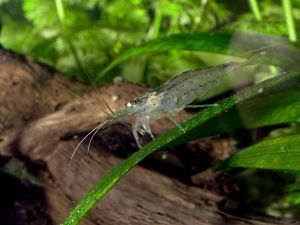Amano Shrimp
Amano shrimp
Species name: Caridina japonica
Amano shrimp are namned after a famous aquarium photographer, Takashi Amano who often photographed this species. Amano shrimps are however known under a long row of different names beside Amano shrimp. These names includes grass shrimp, Yamato Nuna Ebi, Yamato shrimp, algae-eating shrimp, Japanese marsh shrimp, and the Japanese swamp shrimp.It is normally found In swamps and marsh land in Japan where it feeds on algae. Their diet also contains other soft plants.
Amano shrimp has a transparent body with a doted line along the sides and a fan like tail. This makes them very similar to Ghost shrimp but some find the Amano shrimp to be more beautiful than the ghost shrimp largely due to their fan tail and doted lines. They do grow larger than ghost shrimp and Amano shrimp can grow to reach a length of 2 inches / 5 cm. Amano shrimp grows older than most other freshwater shrimp and can become several years old. They are also more considerable more expensive than some similar shrimp such as the ghost shrimp.
They are great scavengers and very good at finding even the smallest food particles among the sand of the aquarium. This makes them good at helping you keeping your aquarium clean. They are also good algae eaters and can help you keep your aquarium free from algae. They do however as earlier mentioned eat soft aquatic plants so they are not suitable for aquariums with plants of this type such as cambomba and myriophyllum. You can easily se if your amino shrimp have eaten by looking at their stomachs which are clearly visible in their transparent bodies.
 Amano shrimp |
Always give your Amano shrimp something to hold on to such as a small plant piece while they are being transported. This will keep the shrimp calmer during the transport and keep the fragile shrimp in better condition for the arrival to their new home.
Amano shrimp are hard to breed since their larvae require salinity in the water to develop and grow. This means that you have to add salt to the water if you want to breed Amano shrimp. Adult shrimp does well in most water types. The young shrimp requires very small food to grow and Amano shrimp are best breed in ponds
They accept most types of food and Amano shrimp can without problem be kept and breed on a diet consisting of flake food. It is however beneficial to supplement their diet with some vegetable food and some frozen or live food.
Didn't find the info you were looking for? Register for free and ask your question in our Aquarium forum !
Our knowledgeable staff usually responds to any question within 24 hours
Related Articles
Amano Algae Eating Shrimp - An article about the algae eating Amano shrimp
Apple snail - An introduction to apple snails.
Aquarium crabs - A guide to aquarium crabs
Black Mystery Snail - An introduction to the Black Mystery Snail
Breeding Crayfish - basics too crayfish breeding
Breeding of Red Clawed Mangrove Crabs - How to breed red clawed crabs
Freshwater shrimp - Information about Freshwater shrimp
Ghost shrimp - Information about Ghost shrimp
Malaysian Rainbow Shrimp - Information on how to keep and breed this shrimp species.
Red Cherry Shrimp - A guide to this Algae eating shrimp.
Red clawed lobsters - A short overview of red claw lobsters (crayfish)
Red Nosed Shrimp - information on keeping this shrimp in aquarium.
Snails: Friend or Foe in the Aquarium? - The biology of snails. Their advantages and disadvantages in an aquarium. How to keep them in check.
